14 Jun 2012
A couple of magazine campaigns were brought to my attention this week. And they ain’t pretty.
First up we had the ‘Victim of Beauty’ fashion spread from Bulgarian magazine 12 featuring beautiful models with violent and sickening injuries. These include a black eye, broken nose, acid burnt skin and a slit throat.
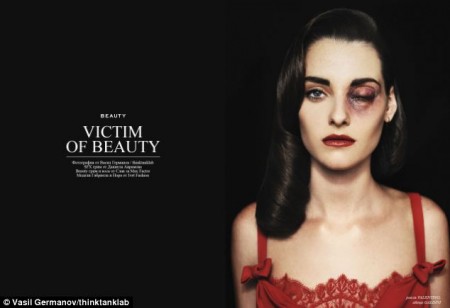
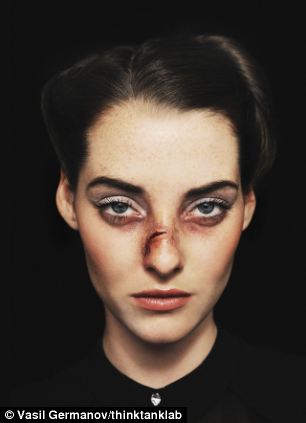
Then Durex very kindly featured the following ad on their Facebook page with the caption ‘Poor woman (or maybe lucky one?)’
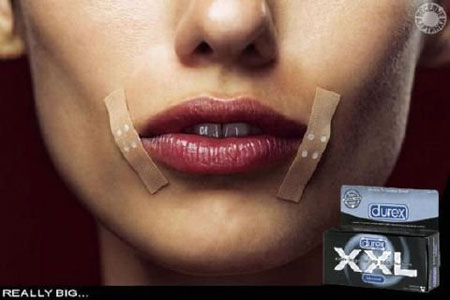
What the hell is going on? How the f**k did these ads ever get made? What creative team is coming up with this kind of stuff? And what client is signing it off?
Creative: So we thought it would be cool to have a woman’s mouth ripped in half because – wait for it – the guy’s c**k is, like, totally huge.
Client: Oh my God, that’s hilarious. Lucky girl.
This is not a recent development either.
This letter (written by moi) appeared in The Face magazine back in 2001 following a succession of brutal and degrading fashion spreads featuring women.
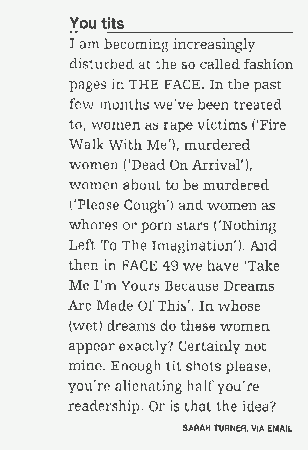
I am becoming increasingly disturbed at the so called fashion pages in THE FACE. In the past few months we’ve been treated to women as rape victims…murdered women…women about to be murdered…and women as whores or porn stars. And then in FACE 49 we have ‘take me I’m yours because dreams are made of this’. In whose (wet) dreams so these women appear exactly? Certainly not mine. Enough tit shots please, you’re alienating half your readership. Or is that the idea?
And remember this ad from Dolce and Gabbana a few years ago? ‘Hey girls, buy a pair of our $300 shoes and you too can get yourself gang raped’.
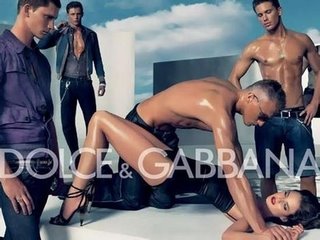
Or this one from suit company, Duncan Quinn. ‘You’ll look so great in our suits, women will let you humiliate them.’
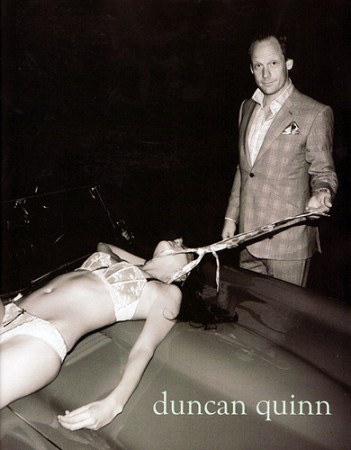
Or ‘misbehave and you’ll be killed and buried in the middle of the desert. But hey, you’ll still look good because you’ll be wearing your Jimmy Choos.’

What’s happening here? Are we getting so desensitized by torture films like Saw and Hostel, that we think portraying violence towards women is acceptable? Funny? Sexy even?
It’s not. It’s really not. On average two women in England and Wales are killed every WEEK by a current or former partner. Sexual and physical violence at the hands of a man affect a staggering 45% of women in the UK sometime in their lives.
Images like this do not help. How can we teach young boys (and girls) compassion, respect, love and kindness when there are so-called uber cool, creatives peddling this kind of crap?
Enough’s enough. If you work at an agency or in-house, come up with better ideas. If you’re asked to do the artwork or photography on these sorts of ads or articles, refuse. If you work at a magazine, don’t accept these ads.
Somebody needs to stand up and say these are not acceptable. Why not you?







joey
Posted at 14:21h, 14 JuneWell, first if all, displaying acts of violence is not the same as endorsing them. Displaying a woman who has had an injury is not in the slightest bit sexist, that point just confuses me. Women get injuries just like men, and I can’t remember the outrage at Popeye’s missing eye. The Durex ad is a fake. The D&G ad really isn’t depicting gang rape. the Duncan Quaid thing, just because some quasi-sexual acts aren’t your cup of tea, doesn’t mean others don’t and it doesn’t mean there is something wrong with it. You did get the Jimmy Choo one almost right. There is no evidence she misbehaved but the idea is that Jimmy Choos even look good in the most despicable situations. Sort of actively saying that killing someone is the worst thing you can do.
Mentioning two films that have absolutely no relation to your point is libellous and based on the most flimsy of arguments (most research debunks any desensitizing theories).
the 45% figure you mention is extremely precarious.
Infact there is almost no evidence whatsoever that we see more violence against women (sexual or non) now than ever before, and there is even less evidence that this is at all related to instances of these sorts of crime actually occurring.
Sarah Turner
Posted at 14:58h, 14 Junehttp://www.whiteribboncampaign.co.uk/Resources/violence_against_women
Katherine
Posted at 14:39h, 14 JuneSarah – can you hear me cheering you on? The Durex advert is obscene!
Bloody brilliant post and more power to your elbow.
Love it. Great work.
Andrew Nattan
Posted at 15:26h, 14 JuneI’m not sure what planet Joey up there is living on, but I imagine it’s much nicer than this one, what with the lack of sexual violence.
Away from the politics, the lizard part of my brain that deals with all the amoral advertising stuff that I’m good at keeps asking a question.
Who thinks “Buying these shoes might get you raped” is a sales message that appeals to women? Who let that idea go in front of a client? Who sat there in that meeting and pitched that idea? Who approved it?
Who buys the bloody rape shoes after seeing that advert?
Tom Albrighton
Posted at 15:49h, 14 JuneThe key to disarming Joey’s disingenuous critique is the concept of power. Which way does power run in these ads? From men to women. Even when women are granted the power of being the target audience, or the consumer, they’re not depicted as powerful in the ads. I’m sure I don’t need to join up the dots in terms of the parallels with society.
With respect to the points made so far, we’ve got to look beyond ‘men bad, women good’. OK, these ads were almost certainly thought up by men. But were they executed, approved and published with no female involvement? Why aren’t more women up in arms about them? Why are the products selling?
What makes this sort of thing so insidious is its subtlety; the sense that there might be some sort of intellectual dimension to it, or a joke that one can be ‘in on’. There isn’t, but that’s how this sort of cultural oppression turns everybody into its victim.
Presumably, the women buying these shoes presumably don’t identify with the victim depicted in the ads. Perhaps it’s the secret enjoyment of watching another woman’s humiliation or pain that gives these products a frisson of excitement or risk. Whatever the psychological dynamic, though, the whole affair is utterly demeaning to everyone involved, from the creatives to the consumers. Whatever the arguments that can be made in terms of free speech or ‘it’s harmless really’, at the end of the day there must be a more edifying way to sell shoes.
joey
Posted at 16:49h, 15 JuneI don’t want you all to misunderstand me, these are pretty dreadful adverts (except for the Durex one, which is a fake). And I agree that I can’t see how they ever made it print, but then, there are a lot of awful and ill-conceived adverts out there. Advertisers often miss the mark and fail to get the message across. (I especially think this is true of the D&G ad, which I don’t think is meant to be gang rape, but it does look like it)
But I’m saying its a large jump to make from a bad idea or execution to actively promoting or supporting the problem (even on such a sensitive and complex subject). Yes these should have been thought through better, but I don’t think it helps anyone to jump straight to moral outrage over it.
Sexual violence is of course a huge problem, and a very emotive subject. Images like these may offend people, but we have come a long way in battling sexism and sexual and domestic violence. We shouldn’t aggrandise errors of judgement into symptoms of moral bankruptcy. That way we see enemies where there were none and make enemies were there was indifference.
To say these images are inherently unacceptable, I feel, is wrong. They are misguided, but not harmful in themselves. You need sand on both sides in order to draw the line.
As for the figure, I didn’t mean to say it didn’t exist, just that BCS surveys are very tricky, because people have very different ideas about what constitutes many of these things and these figures tend to cover a hell of a lot of different things lumped together awkwardly (I have come across some shockingly bad practice). it’s also 8 years old and laws and policing have changed a lot since then in this field.
Again, that’s not to say there isn’t a large problem out there, just that it is important not to create panics which can escalate problems. Any figure above 0 is unnacceptable.
And I apologise if my post came across as hostile.
Sarah Turner
Posted at 18:22h, 15 JuneHey Joey
Thanks for this. The Durex ‘ad’ appeared on their Facebook page. It wasn’t used in the press.
I don’t think anyone is jumping straight to moral outrage. My letter to The FACE was over ten years ago. I’ve been mad about this kind of stuff for years!
That D&G ad is all about lack of power and humiliation. Just because the boys are pretty and she’s not screaming her head off doesn’t make it any less disturbing. The ads were banned of course. But only after the brand’s name was all over the internet.
Just following on from Tom’s comment – there are female creatives, female clients, female models and female photographers who are all responsible for these images too. I buy the kind of magazines that these ads appear in and I buy the products too. We’re all guilty. And all of us need to take responsibility.
My ongoing concern, and I mentioned it in the original post, is how do we teach young kids about respect and kindness? Sorry to be all new age. But when kids as young as 11 are in court for rape, as a society we’re doing something wrong.
How Far Should Advertising Go?
Posted at 10:41h, 27 June[…] This type of graphic advertising is discussed in this wonderful post by Sarah Turner looking at the degredation of women in fashion advertising campaigns.I don’t know about you, but images like that certainly don’t make me want to […]